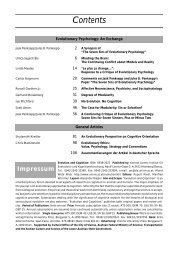Contents - Konrad Lorenz Institute
Contents - Konrad Lorenz Institute
Contents - Konrad Lorenz Institute
You also want an ePaper? Increase the reach of your titles
YUMPU automatically turns print PDFs into web optimized ePapers that Google loves.
Steven M. Platek<br />
“plunge” the vagina of another male’s sperm (see<br />
GALLUP et al. 2003). GALLUP et al. (2003, under review)<br />
and GOETZ, SHACKELFORD and colleagues (in<br />
press) have demonstrated that males behave differently<br />
under conditions of possible sperm competition<br />
that would maximize the capacity for using<br />
their penis to displace another male’s semen. Both<br />
papers report that under conditions of risk for<br />
sperm competition males experienced thrusting<br />
deeper, faster, and more vigorously, which would<br />
serve as an advantage for semen displacement.<br />
The final defense against cuckoldry is to assess paternity<br />
of the child post-parturition. There has been<br />
speculation that males do this by assessing the degree<br />
to which children share resemblance with him<br />
and there is evidence that this strategy is used in humans<br />
and perhaps also other species (see e.g., PLATEK<br />
et al. 2002, 2003; PLATEK 2002; WESTNEAT/SHERMAN<br />
1997; SHERMAN/MORTON 1988). Phenotypic cues<br />
may provide evidence about a man’s actual genetic<br />
relatedness to his putative offspring. These cues<br />
would, of course, concern physical resemblance<br />
(Gaulin, personal communication).<br />
BRESSAN and colleagues (BRESSAN/DAL MARTELLO<br />
2002; see also PAGEL 1997) have suggested that<br />
males would benefit from his children expressing<br />
genes for anonymity of paternity as opposed to paternal<br />
resemblance, but this model is not supported<br />
by data from several studies (see PLATEK, et al. 2002,<br />
PLATEK et al. in press, PLATEK/GALLUP under review).<br />
In addition, BRESSAN et al.’s model makes little sense<br />
from an evolutionary perspective in which determination<br />
of paternity is a critical task for males. Selection<br />
for anonymous looking children makes little<br />
sense bearing in mind the basic principles of inheritance.<br />
The only way in which BRESSAN’s anonymity<br />
model might be accurate is if the rate of cuckoldry<br />
(i.e., EPP) was 50% or greater. However, confirming<br />
earlier reports (MACINTYRE/SOOMAN 1991), recent<br />
studies using DNA fingerprinting have shown that<br />
the incidence of EPP ranges from 1–20% (CERDA-<br />
FLORES et al. 1999; SASSE, MÜLLER, CHAKRABORTY/OTT<br />
1994; SYKES/IRVEN 2000). These studies support the<br />
idea that there is (and was during human evolutionary<br />
history) a substantial risk for EPP as a result of<br />
females engaging in EPCs, and males who were selected<br />
for detecting EPP would have left more descendants<br />
that shared genes in common with them.<br />
Following I attempt to model the way in which paternal<br />
resemblance might affect a male’s decision to<br />
invest resources in children.<br />
GEARY (1999) has outlined a theory of paternal investment<br />
based on psychosocial–evolutionary strategies.<br />
He suggests that paternal investment should<br />
only have evolved if it provided some benefit (increases<br />
in survival rate of children, quality of child,<br />
etc.) to the child (and, by virtue of genetic relatedness,<br />
to the parent). Otherwise selection would have<br />
favored an abandonment strategy which would allow<br />
males the opportunity to engage in additional<br />
reproductive opportunities. GEARY emphasizes the<br />
importance of paternal presence in the development<br />
of offspring, which might have longer-term<br />
fitness consequences (see GEARY 1999). For example,<br />
children without investing fathers often exhibit<br />
subtle social incompetencies, and in the most extreme<br />
case may not survive (e.g., because of malnutrition<br />
or murder by a resentful stepfather). Therefore,<br />
it seems that paternal investment provides<br />
relative, not absolute benefit to the child and<br />
should result in a mixed reproductive strategy<br />
(GEARY 1999). In other words, there should be a<br />
large degree of individual variation in investment<br />
behaviors as a result of weighing the costs of investment<br />
against the costs of losing reproductive opportunities<br />
by investing in offspring that may not share<br />
genes in common. The costs of investment can be<br />
minimized if the male had a mechanism by which<br />
he could determine that he is the source of paternity.<br />
That is, if the male determines with relative,<br />
probabilistic confidence that he is the genetic father,<br />
the costs of lost reproductive opportunities are<br />
significantly lessened or outweighed if his investment<br />
in the child affords him increased fitness with<br />
increased long-term fitness advantages; i.e., as a<br />
function of the father’s investment, the child might<br />
develop certain social competencies that afford the<br />
child increased reproductive opportunities in the<br />
future, enhancing the male’s fitness as a consequence.<br />
If the male is uncertain about paternity, then<br />
abandonment should have been favored by selection.<br />
Additionally, a male could choose to stay with<br />
the female (e.g., taking on a wife and step-child) in<br />
the interest of mating effort (ANDERSON/KAPLAN/<br />
LANCASTER 1999). Abandonment, however, might<br />
allow the male to engage in alternative reproductive<br />
opportunities without the cost of investing valuable<br />
resources on another man’s offspring.<br />
GEARY’s model also suggests that selection would<br />
have favored investment when there were few alternative<br />
reproductive opportunities, which might account<br />
for a male taking on a mate and a step-child in<br />
the interest of additional mating opportunities . I<br />
suggest that this would only happen to the extent<br />
that the male had confidence that he would not be at<br />
Evolution and Cognition ❘ 190 ❘ 2003, Vol. 9, No. 2








